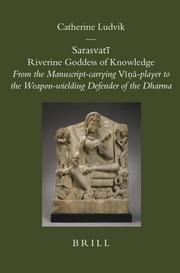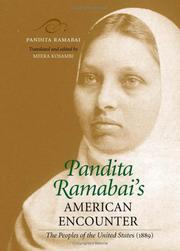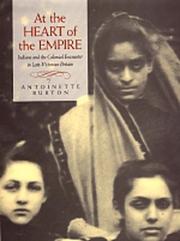| Listing 1 - 10 of 16 | << page >> |
Sort by
|
Book
ISBN: 9781138630444 Year: 2017 Publisher: London ; New York : Routledge, Taylor & Francis Group,
Abstract | Keywords | Export | Availability | Bookmark
 Loading...
Loading...Choose an application
- Reference Manager
- EndNote
- RefWorks (Direct export to RefWorks)
Sarasvatī --- India --- Religion.

ISBN: 1281926337 9786611926335 9047420365 9789047420361 9789004158146 9004158146 9781281926333 661192633X Year: 2007 Publisher: Leiden Boston Brill
Abstract | Keywords | Export | Availability | Bookmark
 Loading...
Loading...Choose an application
- Reference Manager
- EndNote
- RefWorks (Direct export to RefWorks)
This is a fascinating depiction of the transformation of the Indian riverine goddess from the manuscript-carrying vīṇā -player to the Buddhist weapon-wielding defender of the Dharma. Drawing on Sanskrit and Chinese textual sources, as well as Hindu, Jain, and Buddhist art historical representations, this book traces the conceptual and iconographic development of the riverine goddess of knowledge Sarasvatī from some time after 1750 B.C.E. to the seventh century C.E. Through the study of Chinese translations of no longer extant Sanskrit versions of the Buddhist Sutra of Golden Light the author sheds light on Sarasvatī's interactions with other Indian goddess cults and their impact on one another.
Sarasvati --- Sarasvatī (Buddhist deity) --- Buddhist gods --- Sarasvatī --- Ardvī Sūrā --- Saraswati --- India. --- Sarasvatī (Hindu deity) --- Sarasvati (Hindu deity) --- Sarasvati (Buddhist deity)
Book
ISBN: 0195609956 Year: 1978 Publisher: Delphi Oxford university
Abstract | Keywords | Export | Availability | Bookmark
 Loading...
Loading...Choose an application
- Reference Manager
- EndNote
- RefWorks (Direct export to RefWorks)
Dayananda Sarasvati, --- Arya-Samaj --- Biography.
Book
Year: 2007 Publisher: Pune : Pimpri Chinchwad Research Institute,
Abstract | Keywords | Export | Availability | Bookmark
 Loading...
Loading...Choose an application
- Reference Manager
- EndNote
- RefWorks (Direct export to RefWorks)
Purāṇa. Sarasvatī-purāṇa --- Commentaires --- Purāṇa. Sarasvatī-purāṇa --- Commentaires
Book
Year: 1973 Publisher: Thanjavur : Thanjavur Maharaja Serfoji's Saraswati Mahal Library,
Abstract | Keywords | Export | Availability | Bookmark
 Loading...
Loading...Choose an application
- Reference Manager
- EndNote
- RefWorks (Direct export to RefWorks)
Libraries --- Tanjore Maharaja Serfoji's Sarasvati Mahal Library. --- Thanjāvūr --- History.
Book
ISBN: 0444856102 9780444856104 Year: 1985 Volume: nieuwe reeks, 12 Publisher: Amsterdam : North-Holland,
Abstract | Keywords | Export | Availability | Bookmark
 Loading...
Loading...Choose an application
- Reference Manager
- EndNote
- RefWorks (Direct export to RefWorks)
Pusan (Hindu deity) --- Sarasvati (Hindu deity) --- Pūṣan (Hindu deity) --- Sarasvatī (Hindu deity) --- Pūṣan (Hindu deity) --- Sarasvatī (Hindu deity) --- Pūṣan (Hindu deity). --- Pūṣan (Hindu deity). --- Sarasvatī (Hindu deity). --- Sarasvatī (Hindu deity). --- Hindu goddesses --- Pūshan (Hindu deity) --- Hindu gods --- Sarasvatī

ISBN: 9786612071959 1282071955 0253109655 9780253109651 9781282071957 6612071958 0253341906 9780253341907 0253215714 9780253215710 Year: 2003 Publisher: Bloomington : Indiana University Press,
Abstract | Keywords | Export | Availability | Bookmark
 Loading...
Loading...Choose an application
- Reference Manager
- EndNote
- RefWorks (Direct export to RefWorks)
""... [A] rare and remarkable insight into an Indian woman's take on American culture in the 19th century, refracted through her own experiences with British colonialism, Indian nationalism, and Christian culture on no less than three continents.... a fabulous resource for undergraduate teaching."" -- Antoinette Burton In the 1880's, Pandita Ramabai traveled from India to England and then to the U.S., where she spent three years immersed in the milieu of progressive social reform movements of the
Women social reformers --- Social reformers --- Ramabai Sarasvati, --- Paṇḍitā Ramābāī, --- Ramābāī, --- Sarasvati, Ramabai, --- Travel --- United States --- Description and travel. --- Description and travel --- Women social reformers - India - Maharashtra --- Ramabai Sarasvati, - Pandita, - 1858-1922 - Travel - United States --- United States - Description and travel --- Ramabai Sarasvati, - Pandita, - 1858-1922
Book
ISBN: 1280925728 9786610925728 1554581281 9781554581283 Year: 2006 Publisher: Waterloo Wilfrid Laurier University Press
Abstract | Keywords | Export | Availability | Bookmark
 Loading...
Loading...Choose an application
- Reference Manager
- EndNote
- RefWorks (Direct export to RefWorks)
Why, Salmond asks, would nineteenth-century Hindus who come from an iconic religious tradition voice a kind of invective one might expect from Hebrew prophets, Muslim iconoclasts, or Calvinists? Rammohun was a wealthy Bengali, intimately associated with the British Raj and familiar with European languages, religion, and currents of thought. Dayananda was an itinerant Gujarati ascetic who did not speak English and was not integrated into the culture of the colonizers. Salmond's examination of Dayananda after Rammohun complicates the easy assumption that nineteenth-century Hindu ico
Idols and images --- Worship (Hinduism) --- Worship --- History --- Rammohun Roy, --- Dayananda Sarasvati,

ISBN: 0520209583 0520919459 0585031673 9780520919457 9780585031675 9780520209589 Year: 1998 Publisher: Berkeley : University of California Press,
Abstract | Keywords | Export | Availability | Bookmark
 Loading...
Loading...Choose an application
- Reference Manager
- EndNote
- RefWorks (Direct export to RefWorks)
"In this study, Antoinette Burton investigates the colonial empire through the eyes of three of its Indian subjects. The first of these, Pandita Ramabai, arrived in London in 1883 to seek a medical education. She left in 1886, having resisted the Anglican Church's attempts to make her an evangelical missionary, and began a career as a celebrated social reformer. Cornelia Sorabji went to Oxford to study law and became one of the first Indian women to be called to the bar. Already a well-known Bombay journalist, Behramji Malabari traveled to London in 1890 to seek support for his social reform projects. All three left the influence of imperial power keenly during even the most everyday encounters in Britain, and their extensive writings are conscious analyses of how "Englishness" was made and remade in relation to imperialism." "Written clearly and persuasively, this historical treatment of the colonial encounter challenges the myth of Britain's insularity from empire, demonstrating instead that the United Kingdom was a terrain open to contest and refiguration."--Jacket.
East Indians --- Imperialism --- Regions & Countries - Europe --- History & Archaeology --- Great Britain --- History --- Malabari, Behramji M. --- Ramabai Sarasvati, --- Sorabji, Cornelia --- Journeys --- Travel --- India --- Relations --- Social life and customs --- Ethnic relations. --- Asian Indians --- Indians, East --- Indic peoples --- Paṇḍitā Ramābāī, --- Ramābāī, --- Sarasvati, Ramabai, --- Behramji Merwanji Malabari, --- Malabari, Behramji Merwanji, --- Malabārī, Beherāmajī Meravānajī, --- Beherāmajī Meravānajī Malabārī, --- Malabari, Behramji Mervanji, --- Behramji Mervanji Malabari, --- Malabari, Phiroze B. M. --- Indland --- Ḣindiston Respublikasi --- Republic of India --- Bhārata --- Indii︠a︡ --- Inde --- Indië --- Indien --- Sāthāranarat ʻIndīa --- Yin-tu --- Bharat --- Government of India --- Ethnology --- インド --- Indo --- هند --- Индия --- Indians (India)
Book
ISBN: 3319442236 3319442244 Year: 2017 Publisher: Cham : Springer International Publishing : Imprint: Springer,
Abstract | Keywords | Export | Availability | Bookmark
 Loading...
Loading...Choose an application
- Reference Manager
- EndNote
- RefWorks (Direct export to RefWorks)
This book portrays the Himalayan-born River Saraswati, a legendary river that was the lifeline of a progressive and vibrant society for more than three thousand years. Written in simple language and richly illustrated, it highlights the events that resulted in the robbing of the Saraswati of its water and the end of a wonderful culture. The author weaves a geological narrative out of a mass of data generated by explorers, archaeologists, sedimentologists, geohydrologist, seismologists and remonte-sensing specialists. The story explains how a great Himalayan river disappeared and how the Harappan Civilization vanished from the banks of the river Saraswati more than three and half thousand years ago in the wake of tectonic upheavals in the foothills of the Himalaya at a time when the rainfall had drastically declined. And it reveals that nowadays the Saraswati is an extraordinary wide water-less channel coursing through the vast but dry floodplain in western India.
Structural geology. --- Saraswati River (India) --- Geohydrology --- Sarasvati River (India) --- Earth sciences. --- Sedimentology. --- Hydrogeology. --- Geomorphology. --- Archaeology. --- Earth Sciences. --- Structural Geology. --- Geology, Structural. --- Hydraulic engineering. --- Archeology --- Anthropology --- Auxiliary sciences of history --- History --- Antiquities --- Engineering, Hydraulic --- Engineering --- Fluid mechanics --- Hydraulics --- Shore protection --- Geotectonics --- Structural geology --- Tectonics (Geology) --- Physical geology --- Petrology --- Geomorphic geology --- Physiography --- Physical geography --- Landforms --- Geology --- Hydrology --- Groundwater
| Listing 1 - 10 of 16 | << page >> |
Sort by
|

 Search
Search Feedback
Feedback About UniCat
About UniCat  Help
Help News
News